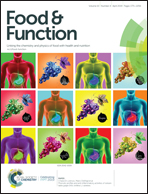Allyl methyl trisulfide protected against acetaminophen (paracetamol)-induced hepatotoxicity by suppressing CYP2E1 and activating Nrf2 in mouse liver†
Abstract
In order to investigate the protective effects of allyl methyl trisulfide (AMTS) on acetaminophen (APAP)-induced hepatotoxicity, 75 KM mice were randomized into 5 groups, i.e. a control group, an APAP group, and three AMTS/APAP groups. The mice in the AMTS/APAP groups and APAP group were gavaged with 25–100 mg kg−1 AMTS or corn oil for 7 d followed by intraperitoneal injection of 300 mg kg−1 APAP, while mice in the control group were treated with a vehicle. We found that AMTS significantly attenuated APAP-induced hepatotoxicity shown by reduced mortality, decreased serum aminotransferase activities, and improved liver histological morphology. APAP overdose resulted in a significant increase of hepatic malondialdehyde (MDA) level and a decrease of the protein levels of NQO-1, γ-GCS, HO-1, and SOD, which was suppressed by AMTS pretreatment. Furthermore, AMTS inhibited the APAP-induced elevation of hepatic p62 and LC3II protein levels. Interestingly, AMTS attenuated the APAP-induced decline of hepatic CYP2E1 protein levels, but AMTS alone led to the decrease of CYP2E1 protein expression in mouse liver. Collectively, these data suggest that AMTS could attenuate APAP-induced hepatotoxicity by suppressing CYP2E1 and activating Nrf2.



 Please wait while we load your content...
Please wait while we load your content...